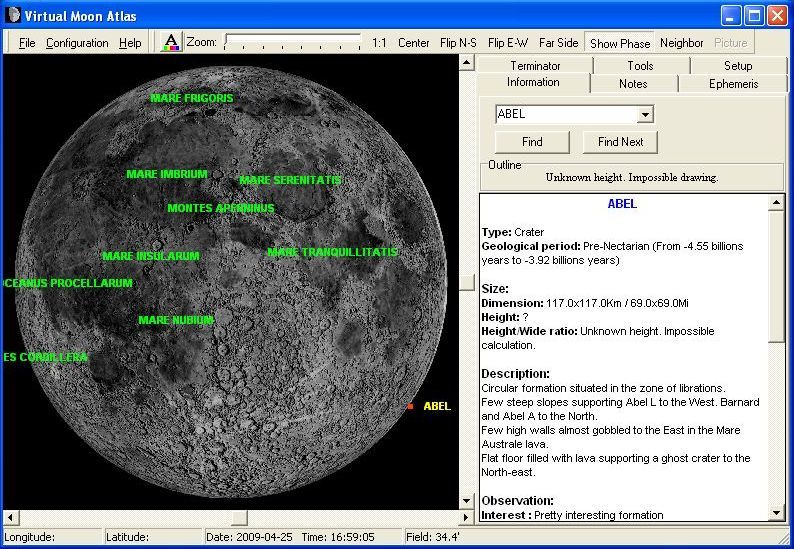

You can swipe left and right on the phase view to go backwards and forwards a day and on the libration chart to go backwards and forwards a month.

In addition, information about the current Moon phase and libration are provided. Over 1800 named features are included as well as 26 spacecraft that reached the surface of the Moon. The Moon globe can be shown with north or south at the top or inverted to suit different telescope views.
INTERACTIVE MOON ATLAS UPDATE
There is also a realtime mode that will update to the current time. The phase can be switched off and the far side is shown in a slightly darker shade of grey.ĭate, time and location can be changed. The feature database is searchable and can move the globe to a searched feature. You can switch to a 'Globe' mode that allows you to spin the Moon around to see far side features. Moon Atlas displays the phase and libration of the Moon from your chosen location and renders these on the globe.

You can double tap on the labels to get more information about a particular feature. As you zoom in more labels appear as finer detail comes into view. This is a rendered sphere and not a static map image. And it’s really neat to see this technology that was developed for our own planet starting to be applied on other planets.Moon Atlas is an astronomy application that lets you use pinch and finger gestures to manipulate a 3D globe of the Moon. I certainly wasn’t aware of all the mapping that has been done by NASA, the European Space Agency, and other organizations. There really is a lot of overlap between “space geeks” and “GIS geeks,” but I’m not sure the average GIS/space geek is aware of how many different bodies in the solar system we’ve mapped. It’s also a great way to inform the public of the return on investment of space exploration programs. Wheeler: Who do you think will use the atlas?Īrtz: The Solar System Atlas promises to be a powerful educational tool for teachers and students, as well as of interest to the general public curious about space, science, and discovery. It’s going to be fun to see the creative uses that people in the GIS community find for these maps! You can find links to each map and more information about them by following the introductory section of the atlas. Wheeler: So beyond the atlas itself, each of these maps is available on ArcGIS Online?Īrtz: Yes, the individual maps are already accessible on ArcGIS Online, which means they are available for public use for a variety of applications other than the Solar System Atlas. The Solar System Atlas contains several maps of Venus derived from imaging radar on the Magellan probe. Because of the different resolutions of the source maps, the user experience varies from map to map, but I think it’s a good start at pulling all of this information together into a single app. So each image was brought into ArcMap and published as an image service to ArcGIS Online, and then displayed in the atlas as an interactive map. So instead of just looking at the images, I wanted people to be able to pan around and zoom in and out-to really “explore” all of these planetary bodies. But rather than simply displaying them as images in the story map, I wanted some level of interactivity. It’s awesome! Can you tell me more about the maps themselves?Īrtz: Most of the maps in the atlas are simple images at varying resolutions, are not georeferenced, and have no attribute data attached. Wheeler: Exploring with the atlas is like taking an interplanetary ride from Earth all around the solar system to see faraway places like the gas giant Jupiter and its moons, dwarf planets such as Pluto and Ceres, and even comets and asteroids. I’m always looking for out-of-the-ordinary ideas for new Story Maps, and I thought it would be real easy to pull 10 to 15 of these maps into a Story Map and call it a “Solar System Atlas.” Then I looked at the NASA website and found a few additional maps, and then a few more, and then … next thing you know, I’ve gathered more than 60 maps from all over the solar system. While working on some story maps about Pluto and Mercury, a colleague mentioned that Trent Hare from the United States Geological Survey (USGS) had loaded a number of planetary basemaps on ArcGIS Online. Wheeler: How did you come up with the idea to build an atlas of the solar system?Īrtz: This whole project started somewhat by accident.
INTERACTIVE MOON ATLAS SOFTWARE
Artz is a GIS and science manager and content strategist for Software Products at Esri. This geologic map of minor planet Vesta was created based on data collected by the Dawn spacecraft.ĪrcWatch editor Carla Wheeler recently tracked down the creator of the Solar System Atlas, Matt Artz, to ask him to shed more light on this Story Map app.


 0 kommentar(er)
0 kommentar(er)
